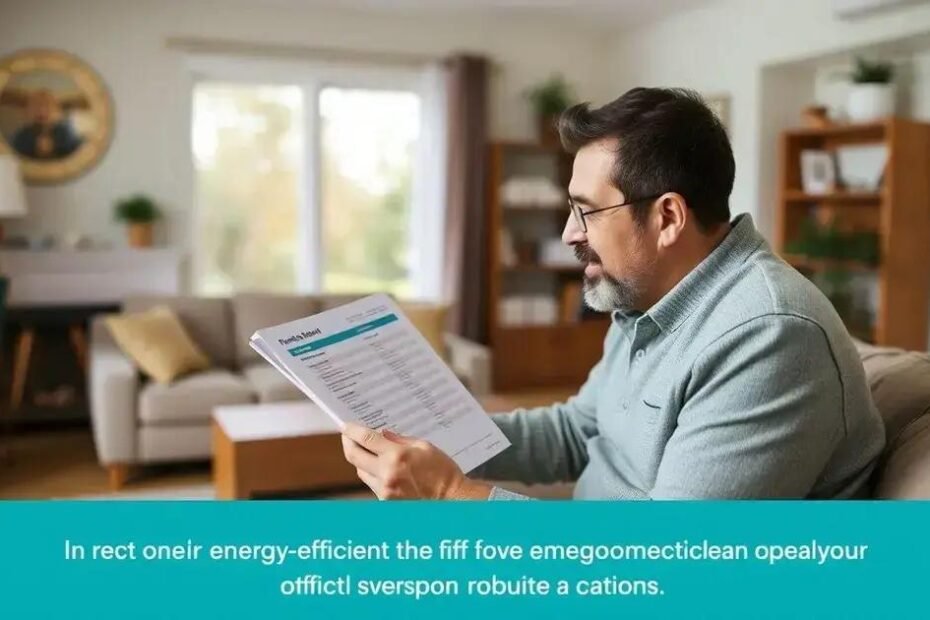Energy-efficient utility rebate programs provide financial incentives for homeowners to upgrade to energy-efficient appliances and systems, significantly reducing energy costs while contributing to sustainability.
Energy-efficient utility rebate plans are not just a way to cut costs; they can also lead to substantial savings on your monthly bills. Have you ever considered how these plans can benefit you? In this article, we’ll delve into the ins and outs of these programs, helping you discover how to take advantage of available rebates.
Understanding energy-efficient utility rebate plans
Understanding energy-efficient utility rebate plans is essential for anyone looking to save money on energy bills while contributing to a more sustainable future. These plans encourage homeowners and businesses to make energy-efficient upgrades by providing financial incentives.
What Are Energy-Efficient Utility Rebate Plans?
These programs are offered by utility companies, governments, or other organizations to promote energy-saving measures. By participating in these plans, you can receive cash rebates or credits that effectively reduce the cost of energy-efficient appliances, insulation, and more.
Benefits of Energy-Efficient Utility Rebate Plans
Here are a few key benefits of participating in these plans:
- Lower monthly energy bills.
- Increased home comfort due to improved insulation and efficient appliances.
- Reduced carbon footprint contributing to environmental sustainability.
- Enhanced property value with energy-efficient features.
Enrolling in these programs is usually straightforward. Most providers have clear guidelines on how to apply and what items are eligible for rebates. Make sure to conduct thorough research to understand the criteria and benefits applicable to your situation.
Additionally, many of these rebate programs come with specific deadlines or budget limits, so it’s crucial to act quickly. Understanding these details can help you maximize your benefits. You could end up saving significantly on your initial investment for energy-efficient upgrades.
Some common upgrades eligible for rebates include LED lighting, energy-efficient HVAC systems, smart thermostats, and proper insulation. The more informed you are about these options, the better equipped you’ll be to take advantage of the programs available.
Benefits of participating in these rebate programs
Participating in rebate programs for energy-efficient utilities provides numerous benefits for homeowners and businesses alike. By choosing to invest in energy efficiency, you not only save on costs but also contribute to a healthier environment.
Financial Savings
One of the most significant advantages is the potential for financial savings. These programs can lower your initial investment in:
- Appliances that reduce energy consumption.
- Insulation that keeps homes warmer in winter and cooler in summer.
- Smart technologies that help you monitor and reduce energy use.
Through these rebates, many families find that their energy bills decrease significantly, offering a tangible way to save money.
Environmental Impact
Moreover, participating in these programs helps promote sustainability. By using energy-efficient products, you contribute to reducing greenhouse gas emissions. Fewer emissions mean a positive impact on air quality and climate change.
This is especially important as communities strive to meet environmental targets and improve public health. Making smarter energy choices supports these goals.
Beyond finances and environment, rebate programs often lead to enhanced comfort. Homes equipped with energy-efficient systems tend to have improved heating and cooling, making for a more pleasant living space.
Smart home technology, which often qualifies for rebates, can also increase convenience. These devices allow you to control energy usage from your smartphone, making it easy to maintain efficiency even when you’re not home.
As you can see, the benefits of participating in energy-efficient utility rebate programs extend well beyond simple savings. They create opportunities for smarter living while fostering a commitment to sustainability.
How to apply for energy-efficient utility rebates

Understanding how to apply for energy-efficient utility rebates is crucial for maximizing your savings. The application process can vary by program, but there are general steps that can guide you through.
Research Available Programs
Start by researching the rebate programs available in your area. Utility companies often list these on their websites. Look for programs that match your needs and the energy-efficient upgrades you plan to make.
Check Eligibility Criteria
Once you find suitable programs, review the eligibility criteria carefully. Common requirements might include:
- Home type and age restrictions.
- Specific energy-efficient products being used.
- Installation by a qualified contractor.
Knowing this information helps ensure that you qualify for the rebates you wish to apply for.
Gather Necessary Documentation
Before applying, gather all required documents. This could include receipts, appliance specifications, and proof of purchase. Ensuring you have everything needed will speed up the approval process.
Next, fill out the application form. Many utility companies offer online applications that are user-friendly. Make sure to provide all the requested details accurately. Missing information can delay your rebate.
Submit Your Application
After completing the application, submit it as directed. Some programs may require you to make copies of your documents for mail submissions, while others allow digital submissions. Whichever method you choose, be sure to keep copies of everything for your records.
Finally, after you submit, check your application status periodically. It’s wise to follow up if you do not receive confirmation within a few weeks. This ensures your application is being processed.
Applying for energy-efficient utility rebates may seem daunting, but with the right preparation, it can be a straightforward process that leads to significant savings.
Common eligibility criteria for rebate programs
Understanding the common eligibility criteria for rebate programs is essential for anyone looking to take advantage of energy-efficient upgrades. Different programs may have specific rules, but several key criteria are frequently shared across many initiatives.
Home Type and Age
Most rebate programs will require the home to meet certain specifications. Common criteria include:
- Single-family homes are often prioritized over multi-family buildings.
- Some programs might limit eligibility to homes built after a specific year.
- New construction may not qualify, focusing instead on existing buildings.
It’s important to check the particulars of each program to understand what type of home qualifies.
Energy-Efficient Product Standards
To receive rebates, the products or upgrades must meet specific energy-efficient standards. Be sure to look for:
- Energy Star certification for appliances.
- Highefficiency HVAC systems that reduce energy usage.
- Insulation products that meet certain R-value specifications.
These standards ensure that the upgrades you are investing in truly yield energy savings.
Professional Installation
Another common requirement is that installations must be completed by qualified professionals. Some programs specify that:
- Contractors need to be certified by the program.
- Homeowners cannot perform self-installations for rebate eligibility.
- All work must comply with local building codes.
By ensuring that a licensed professional handles the installation, programs can verify quality and performance. This adds value by ensuring that the upgrades are optimally effective.
Understanding common eligibility criteria can make the rebate application process more straightforward. Being prepared with knowledge about these rules can significantly enhance your chances of receiving financial incentives for energy-efficient home improvements.
Tips for maximizing your utility rebates
To get the most out of your utility rebates, it is essential to employ effective strategies. By being informed and organized, you can ensure that you maximize your savings. Here are some tips to help you achieve that goal.
Research Available Rebate Programs
Start by thoroughly researching available rebate programs. Utility companies often provide detailed listings on their websites, showcasing different incentives. Look for programs that specifically suit your planned upgrades.
Plan Your Energy-Efficient Upgrades
Take the time to plan your upgrades wisely. Prioritize energy-efficient enhancements that qualify for the most substantial rebates. Here are some options to consider:
- Appliances with the Energy Star label.
- High-efficiency heating and cooling systems.
- Smart thermostats or lighting systems.
By focusing on higher-rebate items, you can stretch your budget and see faster savings.
Keep Accurate Records
Maintaining accurate records is crucial throughout the application process. Make sure to save all purchase receipts, installation documents, and product information. This documentation will streamline your rebate application and serve as proof of your energy-efficient purchases.
Whenever possible, use digital records to keep everything organized and easily accessible. Create folders on your computer or cloud storage to sort documents by program or upgrade type.
Follow Application Guidelines Carefully
Each rebate program will have specific application guidelines. Carefully read and follow these instructions to ensure your application is successful. Pay attention to:
- Submission deadlines, as many programs have a limited time frame.
- Required documentation, which often varies between programs.
- Approval processes that may take several weeks.
By following instructions closely, you will minimize the chances of your application being delayed or rejected.
Maximizing your utility rebates involves being proactive and informed. Stay organized, and carefully navigate each step of the process to ensure you’re getting the maximum benefits available.
The conclusion summarizes the key aspects of participating in energy-efficient utility rebate programs. These programs provide a fantastic opportunity for homeowners to save money while making their homes more sustainable. By understanding eligibility criteria, applying effectively, and maximizing your benefits, you can enjoy substantial savings on energy costs. Staying informed and organized is crucial to ensure you receive the maximum rebate available, turning your energy-efficient upgrades into a wise investment. Here’s a brief overview of the topics covered:
FAQ – Frequently Asked Questions about Energy-Efficient Utility Rebate Programs
What types of upgrades can qualify for rebates?
Common upgrades include Energy Star appliances, high-efficiency HVAC systems, smart thermostats, and insulation.
How do I find available rebate programs in my area?
You can check your utility company’s website or local government resources for listings of available rebate programs.
What documents do I need to apply for a rebate?
Typically, you need receipts, installation documentation, and product specifications for your energy-efficient upgrades.
How can I maximize my utility rebates?
Research eligible programs, prioritize high-rebate items, keep accurate records, and follow application guidelines carefully.

